
SERPwatcher is Mangools Serp Checker tool, and one of the 5 tools that make up their SEO suite.
We like it because it is a quick and easy way to check your SERP positions everyday, automatically.
Why use Serpwatcher Keyword Tracker?
You invest your time in Keyword research, then invest more time or Money in Content creation. But if you want to bring traffic to your site, that is just the start.
The next step is to put your keywords into a web based rank tracker.
There are many reasons to track your results in Serp. The main one is that it helps you to improve your On-page SEO across your entire site. The second is that most of your competition won’t do it.
It is so much harder to influence off-page SEO, but getting your on-page SEO working well is entirely within your control. Knowing which posts, or groups of posts are rising in Search makes it easier to create, or redirect internal links which help to lift the other pages of your website. The end result is more visitors to your site.
Automated Rank Tracker
All you need to do is simply add your keywords into Serpwatcher, and group them together with Tags. From there, Serpwatcher automatically provides daily rank tracking of every keyword.
You can see the overall performance of your site, view different areas of interest, article clusters etc,
and see how each are trending.
It’s easy to quickly review, or to create reports or alerts as your posts reach your target ranking.
You can access Serpwatcher as part of a Mangools Subscription or explore it and the other tools with a Free Trial.

Do you need a Bulk Rank Tracker ?
You may not think so at the start.
You can waste a lot of time trying to manually check Serp rankings. And it might seem manageable while your site is small. But, as your site grows, or you add multiple sites to your portfolio you quickly end up with too many keywords to track.
The number of keywords SERPwatcher tracks for you depends on your Mangools subscription.
If you are on a free trial you can track only 10 keywords, enough to see how it all works.
When you take up a basic plan that number increases to 200 (which is still too limited for most), but the best value comes with a “Premium plan”.
Premium is the most popular option and for only $10 more has many benefits. The one that interests us here is an increase to tracking 700 Keywords in Serpwatcher.
As soon as you start entering words to track, the tracking page tells you how many more words you can add within your existing plan. You can easily add more at any time, without moving to a more expensive Mangools plan.
Just add more words, 500, 1000, 2000, 5000 or up to 10,000 if necessary.
Using a Search Engine Rank Tracker
After setting up your Free Trial, or activating your plan, just click on the Serpwatcher tab at the top of the page and select New Tracking.
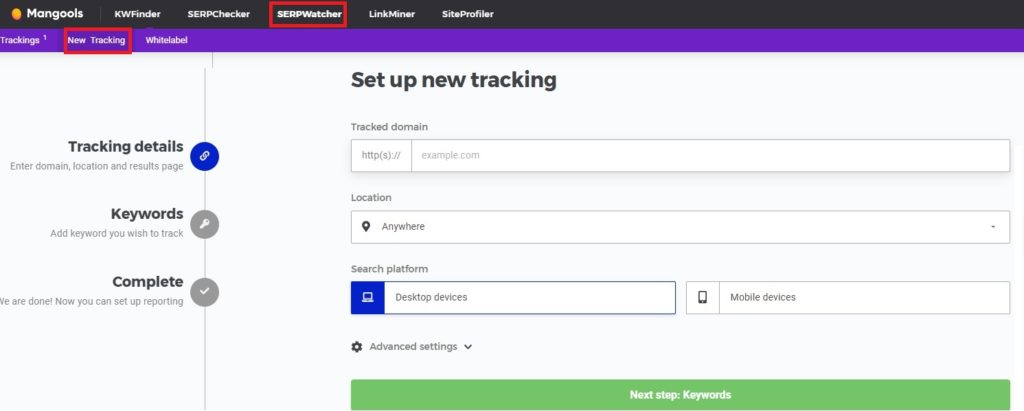
You will need to add the domain name that you want to track, the location to check rankings for and choose between Desktop and Mobile search results.
A couple of things to note, there are more than 50,000 locations being reported on, so you can go global, chose a national market, or if you want local results, use Serpwatcher for Google local rank tracking. Just start typing your city etc directly into the location box.
You cannot toggle between Desktop and Mobile results, or between locations. So if you want to track both Desktop and Mobile you need to set up two trackings. Same with different locations. Each is a separate tracking, with the same keywords in each. But, every keyword in each tracking group counts toward your total keyword allowance as well.
There are 4 ways to add Keywords. Either add them manually, transfer lists from KWFinder, or upload form either a TXT or CSV file.
You can not only track keywords relevant to your site, but by creating a separate tracking, you can add a competitor’s domain and track it’s performance for your keywords and locations over time as well.
Navigating the Serpwatcher Dashboard
To illustrate, we have borrowed some images from Mangools.com rather than use our own data.
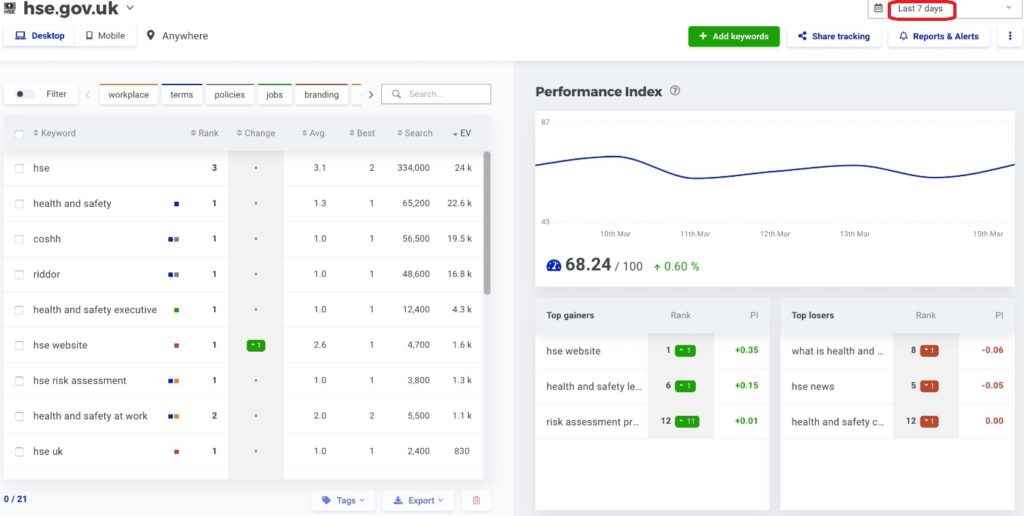
There are basically two blocks on the reporting screen, the left side contains specific data for keywords you have entered , and the right will show performance metrics over time.
Individual Keyword data
If you look at the top right corner, you can see that this data is for the past 7 days.
You can view “today”, the past 7 days, 30 days, 90 days or the entire history from when you entered the keyword.
The results show the actual Serp rank, the change in rank, the average rank position for the timeframe, and highest rank reached. You can also see the search volume and an estimate of the number of visits this word will generate at your current ranking.
Performance and Trends
On the right you will see a graph of the Performance index for this group overtime. A table of the keywords that are rising and falling, a graph of estimated visits to your site, and both a table and interactive graph of the number of keywords you have at various ranking levels.
It is important to note that unfortunately, Serpwatcher does not import historical data.
When you add a keyword, it starts collecting information going forward. So, if you add a word today, you will have to wait 7 days to see its results over a week, or 30 days to see its results over a month etc.
Sharing Serpwatcher Results and creating Alerts

Using these tabs, you can share the results screen via a link, or set up weekly or monthly email reporting to your own email or to members of your team. The same applies to alerts as your keywords hit selected milestones etc.
It’s easy to add or remove keywords to tracking groups, or to add or remove entire tracking groups at anytime.
Let’s look at the Left hand panel in detail
The data is easily sorted by clicking on the headings of the data columns. Even so, as your number of keywords grows you will enjoy the search option to find things more quickly.
To explore and manage results, you can use the Filters to bring up keywords with specific attributes. Stipulate a certain rank range, a specific search volume, or the number resulting site visits. Alternatively, choose to include or exclude specific words. For example, collect all the “how to” keywords to see if they are out performing the “best of” words etc
Managing Keyword Data
Serpwatcher uses tags so you can group together keywords and metrics for whatever reason you choose. Creating a new Tag is simple using the “Add Tags” button.

Just name the Tag, select a color and click Create tag. To link the tag to a Keyword, simply select the Keyword, click on “tags”, check the desired Tag by name, and hit “assign”.
Once the Tags are created, simply add the Tag to your keyword as each new word is added to your Tracking group.
As each Tag is created, it appears at the top of the page right by the “Filter” button. We will look at their use shortly, as we review the metrics on the right side of the screen.
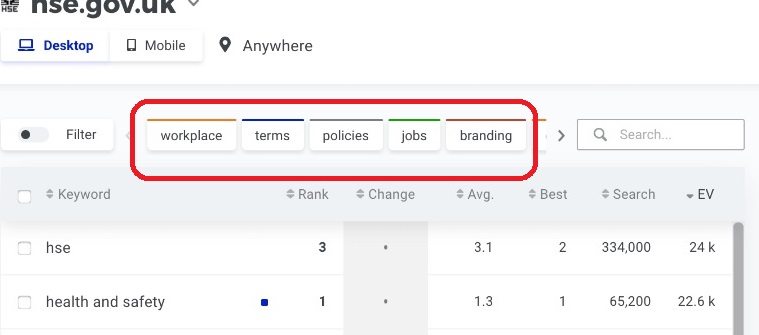
The right side is about exploring your Serp results for keywords or groups of words.
Either click on a Tag or a single keyword in the left panel, and the data in the right adjusts to reflect your selection.
Reviewing your results in Google Serp
Results in the right hand panels relate to the timeframe selected at the top and the group of keywords selected and displayed in the left panel. So, either all of the keywords for the domain, or those you have linked under an specific tag or a group you are looking at by using a Filter.
The first Metric is the Performance Index and this is calculated daily.
Serpwatcher Performance Index
This is a comparative score for the Keyword (or for a group of Tagged keywords). It uses your actual Serp rank, together with the traffic volume for the keyword to create a indicator of how you are performing in Serp overtime.
Movements in higher ranked Keywords, or movements for keywords with higher search volumes have a bigger impact on your PI score than smaller, or lower ranked words.
The higher your PI score the stronger your position for the individual keyword, or the Tagged group. You can also see a PI score for any group of keywords created when using the Filters. Your “how to” keywords for example.
Gainers and losers
Below the PI graph is a table of the keywords in this group with the biggest gains or fall for the period. Clicking on any of the keywords will bring up its Rankings over time, the search volume changes and link you through to Serp to review the listing.
Estimated Visits
Based on the search volume for the keyword and your organic ranking, this is an estimate only. For the actual traffic check your Google search console. The graph shows predicted change overtime, and below are the pages with the larger increases or decreases in visits. Again clicking on the Keywords will bring up their specific data.
Keyword Position Flow
This is not a particularly useful detail, unless you see a very large proportion of posts going down. It is just a quick overview of which way your tracked keywords are moving.
Keyword Position Distribution
We find this to be a much more useful view of how the Domain you are tracking, or the group of keywords under a given Tag is performing. The percentage of keywords ranking in the Top 10 compared to the percentage outside of the top 100 give an instant reflection of how much more work you need to do in this part of your content.
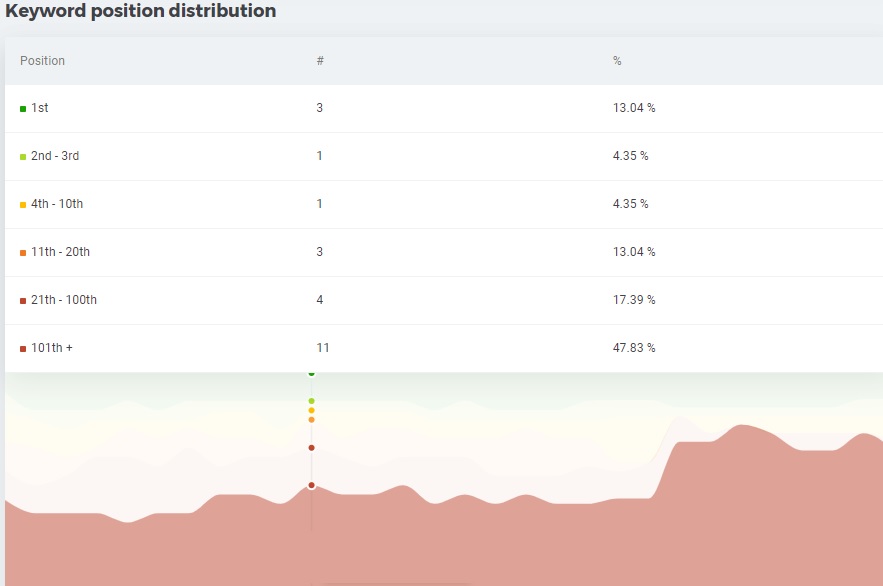
The colored graphical representation is perfect for a quick overview. Just don’t panic if your are publishing a lot of content, and your 101+ graph is growing too fast. Obviously it takes time for your content to gain traction in Serp.
Exploring Individual keyword performance with Serpwatcher
Start by clicking on any keyword in the left panel, and the right side is now reporting on this one keyword alone.

First is the ranking history for this keyword overtime. If you trace the ranking line with your mouse, you will see the individual dates that the ranking was achieved. By clicking the mouse, you can add and save a comment to explain why a spike or dip occurred.
Below the chart is a list of your URL’s that are ranking for that Keyword.
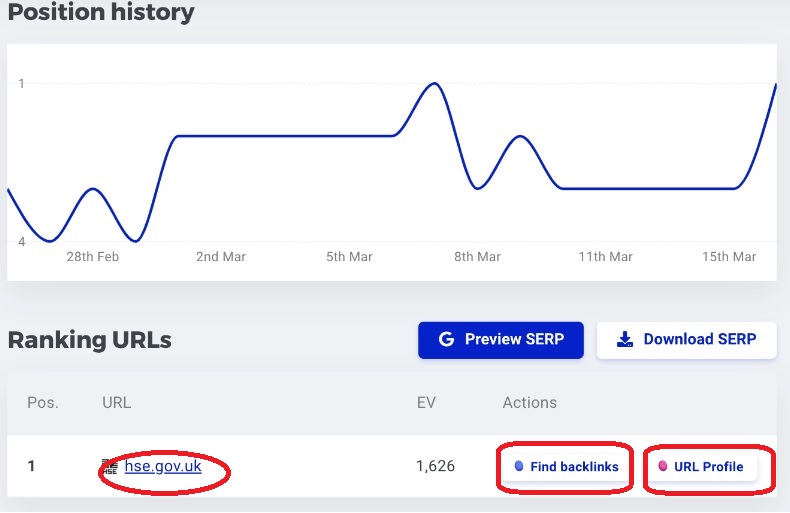
To explore the backlinks coming to each URL, click on the “find Backlinks button” This will take you to the Mangools Linkminer tool”. Alternatively you use the URL Profile button, to see the metrics as collected by Siteprofiler.
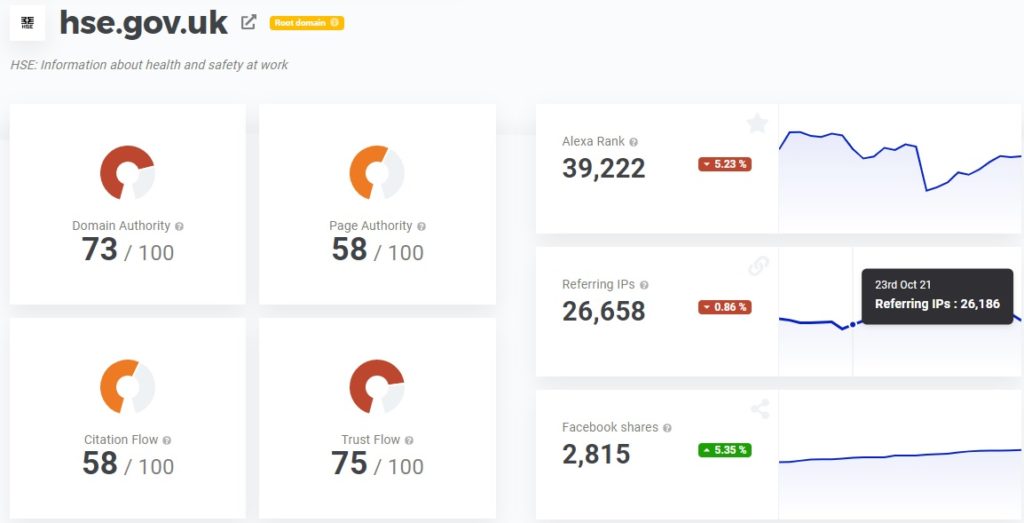
Next is the search volume history for the search term or Tagged group.

As mentioned earlier, SERPwatcher starts collecting data for your keyword as soon as the word is added to a Tracking list. So it can give you the entire history at a glance.
Knowing which of your search terms is generating increasing searches is an indication that a growing opportunity exists in that area. You can boost your internal linking to pages like this to further support your Serp rank for the term, or look to generate incoming links to get a bigger share of the traffic to your site.
Benefiting from Mangools SEO tools
As you can see, each of the Mangools tools works effortlessly with the others:
You can read more about the other tools here:
- KWFinder
- SERPchecker
- SERPwatcher
- Linkminer
- Siteprofiler
Together they give you a powerful collection of SEO options, and they all come together in a single low cost subscription.
You can also explore them all with the one 10 day Free trial here.
Accurate Rank tracker

Our overall rating for Serpwatcher is 8/10
After years of use, we are comfortable that the results we get with SERPwatcher are accurate.
That doesn’t mean that you will always find your site ranked in the position that Serpwatcher says it’s in.
Rankings change constantly in Google through the day, so the number to rely on is the Average position.

Leave a Reply